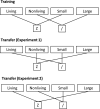Learning a nonmediated route for response selection in task switching
- PMID: 25663003
- PMCID: PMC4520761
- DOI: 10.3758/s13421-015-0507-5
Learning a nonmediated route for response selection in task switching
Abstract
Two modes of response selection--a mediated route involving categorization and a nonmediated route involving instance-based memory retrieval--have been proposed to explain response congruency effects in task-switching situations. In the present study, we sought a better understanding of the development and characteristics of the nonmediated route. In two experiments involving training and transfer phases, we investigated practice effects at the level of individual target presentations, transfer effects associated with changing category-response mappings, target-specific effects from comparisons of old and new targets during transfer, and the percentages of early responses associated with task-nonspecific response selection (the target preceded the task cue on every trial). The training results suggested that the nonmediated route is quickly learned in the context of target-cue order and becomes increasingly involved in response selection with practice. The transfer results suggested that the target-response instances underlying the nonmediated route involve abstract response labels coding response congruency that can be rapidly remapped to alternative responses, but not rewritten when category-response mappings change after practice. Implications for understanding the nonmediated route and its relationship with the mediated route are discussed.
Figures







Similar articles
-
Categorization difficulty modulates the mediated route for response selection in task switching.Psychon Bull Rev. 2018 Oct;25(5):1958-1967. doi: 10.3758/s13423-017-1416-3. Psychon Bull Rev. 2018. PMID: 29274057
-
Modeling graded response congruency effects in task switching.Acta Psychol (Amst). 2014 Nov;153:160-8. doi: 10.1016/j.actpsy.2014.10.006. Epub 2014 Nov 8. Acta Psychol (Amst). 2014. PMID: 25463557
-
Isolating a mediated route for response congruency effects in task switching.J Exp Psychol Learn Mem Cogn. 2015 Jan;41(1):235-45. doi: 10.1037/xlm0000049. Epub 2014 Jul 28. J Exp Psychol Learn Mem Cogn. 2015. PMID: 25068859
-
Transfer of test-enhanced learning: Meta-analytic review and synthesis.Psychol Bull. 2018 Jul;144(7):710-756. doi: 10.1037/bul0000151. Epub 2018 May 7. Psychol Bull. 2018. PMID: 29733621 Review.
-
Unintentional and intentional learning of noncorresponding stimulus-response associations in the Simon task.Acta Psychol (Amst). 2011 Feb;136(2):217-24. doi: 10.1016/j.actpsy.2010.05.005. Epub 2010 Jun 3. Acta Psychol (Amst). 2011. PMID: 20605125 Review.
Cited by
-
Target-Response Associations Can Produce Response-Congruency Effects Without Task-Switching Costs.Front Psychol. 2019 Feb 11;10:40. doi: 10.3389/fpsyg.2019.00040. eCollection 2019. Front Psychol. 2019. PMID: 30804824 Free PMC article.
-
Exploring the impact of compound retrieval strategy in the task-switching paradigm.Front Hum Neurosci. 2025 Aug 5;19:1570551. doi: 10.3389/fnhum.2025.1570551. eCollection 2025. Front Hum Neurosci. 2025. PMID: 40836944 Free PMC article.
-
Categorization difficulty modulates the mediated route for response selection in task switching.Psychon Bull Rev. 2018 Oct;25(5):1958-1967. doi: 10.3758/s13423-017-1416-3. Psychon Bull Rev. 2018. PMID: 29274057
-
On the Role of Attention in Working Memory for Response Selection in Task Switching.J Cogn. 2019 Aug 8;2(1):34. doi: 10.5334/joc.69. J Cogn. 2019. PMID: 31517244 Free PMC article.
-
Exploring the ERP trace of task-set control in the composite design task-switching paradigm.Front Hum Neurosci. 2025 May 8;19:1536926. doi: 10.3389/fnhum.2025.1536926. eCollection 2025. Front Hum Neurosci. 2025. PMID: 40406600 Free PMC article.
References
-
- Anderson JR. How can the human mind occur in the physical universe? Oxford University Press; New York: 2007.
-
- Anderson JR, Lebiere C. The atomic components of thought. Erlbaum; Mahwah, NJ: 1998.
-
- Bernstein IH, Segal EM. Set and temporal integration. Perception & Psychophysics. 1968;4:233–236.
-
- Biederman I. Mental set and mental arithmetic. Memory & Cognition. 1973;1:383–386. - PubMed
-
- Brown JW, Reynolds JR, Braver TS. A computational model of fractionated conflict-control mechanisms in task-switching. Cognitive Psychology. 2007;55:37–85. - PubMed
MeSH terms
Grants and funding
LinkOut - more resources
Full Text Sources
Other Literature Sources

